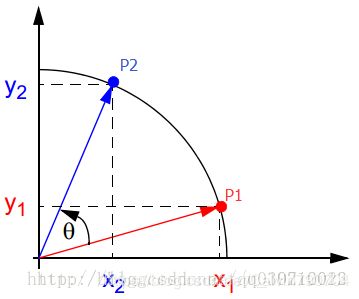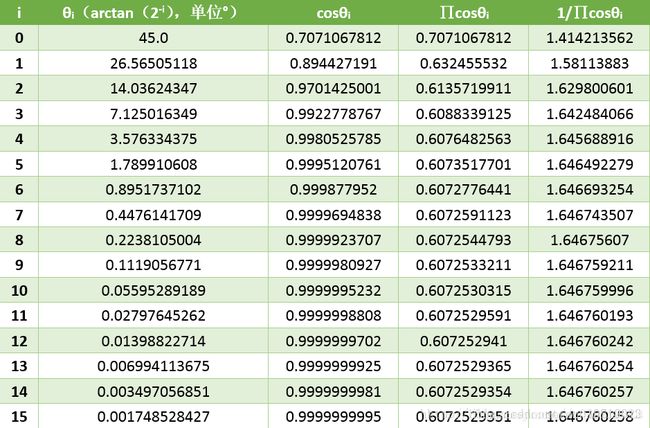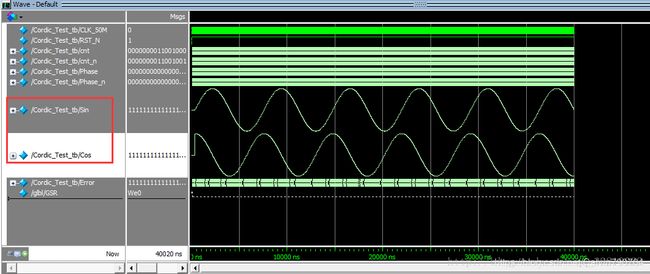cordic算法详解
作者:善良的一休君
来源:CSDN
原文:https://blog.csdn.net/qq_39210023/article/details/77456031
版权声明:本文为博主原创文章,转载请附上博文链接!
---------------------
目前,学习与开发FPGA的程序员们大多使用的是Verilog HDL语言(以下简称为Verilog),关于Verilog的诸多优点一休哥就不多介绍了,在此,我们将重点放在Verilog的运算操作上。
我们都知道,在Verilog中,运算一般分为逻辑运算(与或非等)与算术运算(加减乘除等)。而在一开始学习Verilog时,老司机一定会提醒我们,“切记,千万别用‘/’除、‘%’取模(有的也叫取余)和‘**’幂。”这话说的不无道理,因为这三个运算是不可综合的。但,需清楚理解的是,不可综合的具体意思为不能综合为简单的模块,当我们在程序中调用了这些运算时,‘/’除和‘%’取模在Quartus软件中是可以综合的,因此可以正常调用运行,但是会消耗一些逻辑资源,而且会产生延时,即这两个运算的处理时间会很长,可能会大于时序控制时钟的单周期时间。此时呢,我们会建议你调用IP核来实现运算操作,虽然这样也会消耗许多逻辑资源,但产生的延时相对较小满足了你基本的需求。
问题好像迎刃而解了,可是仔细一想,除了这些运算,我们还剩下什么?对呀,三角函数,反三角函数,对数函数,指数函数呢,这些函数我们在高中就学习了的呀,难道在FPGA中就没有用武之地吗?有人会说,查找表呗,首先将某个运算的所有可能的输入与输出对一一罗列出来,然后放进Rom中,然后根据输入查表得到输出。这个方法虽然有效的避免了延时问题,却是一个十分消耗资源的方法,不适合资源紧张的设计。那么,就真的没有办法了吗?
答案就是咱们今天的标题了,CORDIC,而且CORDIC是一个比较全能的算法,通过这一原理,我们可以实现三角函数,反三角函数,对数函数,指数函数等多种运算。接下来,一休哥就带领大家来学习CORDIC的原理吧。(题外话:请相信一休哥,本文不会让你感到太多痛苦~)
本文将分三个小部分来展开介绍:
1、CORDIC的基本原理介绍
2、CORDIC的具体操作流程介绍
3、CORDIC的旋转模式——Verilog仿真
本文涉及到的全部资料链接:
链接:http://pan.baidu.com/s/1gfrJzMj 密码:x92u
一、CORDIC的基本原理介绍
CORDIC算法是一个“化繁为简”的算法,将许多复杂的运算转化为一种“仅需要移位和加法”的迭代操作。CORDIC算法有旋转和向量两个模式,分别可以在圆坐标系、线性坐标系和双曲线坐标系使用,从而可以演算出8种运算,而结合这8种运算也可以衍生出其他许多运算。下表展示了8种运算在CORDIC算法中实现的条件。
首先,我们先从旋转模式下的圆坐标系讲起,这也是CORDIC方法最初的用途。
1、CORDIC的几何原理介绍
假设在xy坐标系中有一个点P1(x1,y1),将P1点绕原点旋转θ角后得到点P2(x2,y2)。
于是可以得到P1和P2的关系。
x2 = x1cosθ – y1sinθ = cosθ(x1 – y1tanθ)
y2 = y1cosθ + x1sinθ = cosθ(y1 +x1tanθ)
以上就是CORDIC的几何原理部分,而我们该如何深入理解这个几何原理的真正含义呢?
从原理中,我们可以知道,当已知一个点P1的坐标,并已知该点P1旋转的角度θ,则可以根据上述公式求得目标点P2的坐标。然后,麻烦来了,我们需要用FPGA去执行上述运算操作,而FPGA的Verilog语言根本不支持三角函数运算。因此,我们需要对上述式子进行简化操作,将复杂的运算操作转换为一种单一的“迭代位移”算法。那么,接下来我们介绍优化算法部分。
2、CORDIC的优化算法介绍
我们先介绍算法的优化原理:将旋转角θ细化成若干分固定大小的角度θi,并且规定θi满足tanθi = 2^(-i),因此∑θi的值在[-99.7°,99.7°]范围内,如果旋转角θ超出此范围,则运用简单的三角运算操作即可(加减π)。
然后我们需要修改几何原理部分的假设,假设在xy坐标系中有一个点P0(x0,y0),将P0点绕原点旋转θ角后得到点Pn(xn,yn)。
于是可以得到P0和Pn的关系。
xn = x0cosθ – y0sinθ = cosθ(x0 – y0tanθ)
yn = y0cosθ + x0sinθ = cosθ(y0 + x0tanθ)
然后,我们将旋转角θ细化成θi,由于每次的旋转角度θi是固定不变的(因为满足tanθi = 2^(-i)),如果一直朝着一个方向旋转则∑θi一定会超过θ(如果θ在[-99.7°,99.7°]范围内)。因此我们需要对θi设定一个方向值di。如果旋转角已经大于θ,则di为-1,表示下次旋转为顺时针,即向θ靠近;如果旋转角已经小于θ,则di为1,表示下次旋转为逆时针,即也向θ靠近。然后我们可以得到每次旋转的角度值diθi,设角度剩余值为zi+1,则有zi+1 = zi - diθi,其中z0为θ。如此随着i的增大,角度剩余值zi+1将会趋近于0,此时运算结束。(注:可以发现,di与zi的符号位相同)
第一次旋转θ0,d0为旋转方向:
x1 = cosθ0(x0 – d0y0tanθ0)
y1 = cosθ0(y0 + d0x0tanθ0)
第二次旋转θ1,d1为旋转方向:
x2 = cosθ1(x1 – d1y1tanθ1) = cosθ1cosθ0(x0 – d0y0tanθ0 – d1y0tanθ1 – d1d0 x0tanθ1 tanθ0)
y2 = cosθ1(y1 + d1x1tanθ1) = cosθ1cosθ0(y0 + d0x0tanθ0 + d1x0tanθ1 – d1d0y0tanθ1 tanθ0)
大家可能已经发现了,在我们旋转的过程中,式子里一直会有tanθi和cosθi,而每次都可以提取出cosθi。虽然我们的FPGA无法计算tanθi,但我们知道tanθi = 2^(-i),因此可以执行和tanθi效果相同的移位操作 2^(-i)来取代tanθi。而对于cosθi,我们可以事先全部提取出来,然后等待迭代结束之后(角度剩余值zi+1趋近于0,一般当系统设置最大迭代次数为16时zi+1已经很小了),然后计算出∏cosθi的值即可。
总结一下:
迭代公式有三:
xi+1 = xi – d iy i 2^(-i),提取了cosθi, 2^(-i)等效替换了tanθi之后
yi+1 = yi + d ix i 2^(-i),提取了cosθi, 2^(-i)等效替换了tanθi之后
zi+1 = zi - diθi
其中i从0开始迭代,假设当i = n-1时,zn趋近于0,迭代结束。然后对结果乘上∏cosθi(i从0至n-1),于是得到点Pn(xn∏cosθi,yn∏cosθi),此时的点Pn就近似等于之前假设中的点Pn(xn,yn)了,所以此时的点Pn同样满足之前假设得到的公式:
xn∏cosθi = x0cosθ – y0sinθ
yn∏cosθi = y0cosθ + x0sinθ
由于i从0至n-1,所以上式可以转化成下式:
xn = 1/∏cosθi(x0cosθ – y0sinθ),(其中i从0至n-1)
yn = 1/∏cosθi(y0cosθ + x0sinθ),(其中i从0至n-1)
注意:上式中的xn,yn是经过迭代后的结果,而不是之前假设中的点Pn(xn,yn)。了解这点是十分重要的。
根据高中学的三角函数关系,可以知道cosθi = 1/[(1+tan2θi)^0.5] = 1/[(1+2^(-2i))^0.5],而1/[(1+2^(-2i))^0.5]的极值为1,因此我们可以得出一个结论:当i的次数很大时,∏cosθi的值趋于一个常数。
关于如何计算∏cosθi的代码如下所示:
close all;
clear;
clc;
% 初始化
die = 16;%迭代次数
jiao = zeros(die,1);%每次旋转的角度
cos_value = zeros(die,1);%每次旋转的角度的余弦值
K = zeros(die,1);%余弦值的N元乘积
K_1 = zeros(die,1);%余弦值的N元乘积的倒数
for i = 1 : die
a = 2^(-(i-1));
jiao(i) = atan(a);
cos_value(i) = cos(jiao(i));
if( i == 1)
K(i) = cos_value(i);
K_1(i) = 1/K(i);
else
K(i) = K(i-1)*cos_value(i);
K_1(i) = 1/K(i);
end
end
jiao = vpa(rad2deg(jiao)*256,10)
cos_value = vpa(cos_value,10)
K = vpa(K,10)
K_1 = vpa(K_1,10)
这里写图片描述
从上表也可以看出,当迭代次数为16,i=15时,cosθi的值已经非常趋近于1了,∏cosθi的值则约等于0.607253,1/∏cosθi为1.64676。所以当迭代次数等于16时,通过迭代得到的点Pn坐标已经非常接近之前假设中的点Pn。所以,当迭代次数等于16时,这个式子是成立的。
xn = 1/∏cosθi(x0cosθ – y0sinθ),(其中i从0至n-1)
yn = 1/∏cosθi(y0cosθ + x0sinθ),(其中i从0至n-1)
此时,已知条件有三个x0、y0和θ。通过16次迭代,我们可以得到xn和yn。而式中的∏cosθi是个随i变化的值,我们可以预先将其值存入系统中。
然后,我们人为设置x0 = ∏cosθi,y0 = 0,则根据等式,xn = cosθ,yn = sinθ。其中1/∏cosθi的值我们也同样预先存入系统中。如此,我们就实现了正弦和余弦操作了。
二、CORDIC的具体操作流程介绍
1、CORDIC的旋转模式
由于算法较复杂,一休哥再总结一些具体的操作流程。
1、 设置迭代次数为16,则x0 = 0.607253,y0 = 0,并输入待计算的角度θ,θ在[-99.7°,99.7°]范围内。
2、 根据三个迭代公式进行迭代,i从0至15:
xi+1 = xi – d iy i2-i
yi+1 = yi + d ix i2-i
zi+1 = zi - diθi
注:z0 = θ,di与zi同符号。
3、 经过16次迭代计算后,得到的x16 和y16分别为cosθ和sinθ。
至此,关于CORDIC的三角函数cosθ和sinθ的计算原理讲解结束。
关于CORDIC算法计算三角函数cosθ和sinθ的MATLAB代码如下所示:
close all;
clear;
clc;
% 初始化
die = 16;%迭代次数
x = zeros(die+1,1);
y = zeros(die+1,1);
z = zeros(die+1,1);
x(1) = 0.607253;%初始设置
z(1) = pi/4;%待求角度θ
%迭代操作
for i = 1:die
if z(i) >= 0
d = 1;
else
d = -1;
end
x(i+1) = x(i) - d*y(i)*(2^(-(i-1)));
y(i+1) = y(i) + d*x(i)*(2^(-(i-1)));
z(i+1) = z(i) - d*atan(2^(-(i-1)));
end
cosa = vpa(x(17),10)
sina = vpa(y(17),10)
c = vpa(z(17),10)
2、CORDIC的向量模式
讲完了旋转模式后,我们接着讲讲向量模式下的圆坐标系。
在这里,我们需从头来过了,假设在xy坐标系中有一个点P0(x0,y0),将P0点绕原点旋转θ角后得到点Pn(xn,0),θ在[-99.7°,99.7°]范围内。
于是可以得到P0和Pn的关系:
xn = x0cosθ – y0sinθ = cosθ(x0 – y0tanθ)
yn = y0cosθ + x0sinθ = cosθ(y0 + x0tanθ) = 0
如何得到Pn(xn,yn)一直是我们的目标。而此时,我们还是列出那几个等式:
根据三个迭代公式进行迭代,i从0至15:
xi+1 = xi – d iy i2-i
yi+1 = yi + d ix i2-i
zi+1 = zi - diθi
不过此时我们尝试改变初始条件:
设置迭代次数为16,则x0 = x,y0 = y,z0 = 0,di与yi的符号相反。表示,经过n次旋转,使Pn靠近x轴。
因此,当迭代结束之后,Pn将近似接近x轴,此时yn = 0,可知旋转了θ,即zn = θ = arctan(y/x)。
而
xn = 1/∏cosθi(x0cosθ – y0sinθ),(其中i从0至n-1)
yn = 1/∏cosθi(y0cosθ + x0sinθ),(其中i从0至n-1)
因此,可得ycosθ + xsinθ = 0,
xn = 1/∏cosθi(xcosθ – ysinθ) = 1/∏cosθi{ [ (xcosθ – ysinθ)^2]^(1/2)}
= 1/∏cosθi{ [ x2cos2θ + y2sin2θ – 2xysinθcosθ]^(1/2)}
= 1/∏cosθi{ [ x2cos2θ + y2sin2θ + y2 cos2θ + x2sin2θ]^(1/2)}
= 1/∏cosθi{ [ x2 + y2]^(1/2)}
由上可以知道,我们通过迭代,就算出了反正切函数zn = θ = arctan(y/x),以及向量OP0(x,y)的长度 d = xn * ∏cosθi。
关于反正切函数,一休哥要多啰嗦几句了,由于θ在[-99.7°,99.7°]范围内,所以我们输入向量OP0(x,y)时,需要保证其在第一、四象限。
关于CORDIC算法计算反三角函数arctanθ的MATLAB代码如下所示:
close all;
clear;
clc;
% 初始化
die = 16;%迭代次数
x = zeros(die+1,1);
y = zeros(die+1,1);
z = zeros(die+1,1);
x(1) = 100;%初始设置
y(1) = 200;%初始设置
k = 0.607253;%初始设置
%迭代操作
for i = 1:die
if y(i) >= 0
d = -1;
else
d = 1;
end
x(i+1) = x(i) - d*y(i)*(2^(-(i-1)));
y(i+1) = y(i) + d*x(i)*(2^(-(i-1)));
z(i+1) = z(i) - d*atan(2^(-(i-1)));
end
d = vpa(x(17)*k,10)
a = vpa(y(17),10)
c = vpa(rad2deg(z(17)),10)
三、CORDIC的旋转模式——Verilog仿真
一休哥在编写CORDIC算法时,采用了16级流水线,仿真效果十分明显。以下是顶层文件的代码。
为了避免浮点运算,为了满足精度要求,一休哥对每个变量都放大了2^16倍,并且引入了有符号型reg和算术右移。
关于Verilog代码的编写,一休哥已经不想多说了,因为代码是完全符合我之前所讲的CORDIC的原理与MATLAB仿真代码。相信大家在看完本文的前两个部分之后,对Verilog的理解应该不是难事儿。
module Cordic_Test
(
CLK_50M,RST_N,
Phase,
Sin,Cos,Error
);
input CLK_50M;
input RST_N;
input [31:0] Phase;
output [31:0] Sin;
output [31:0] Cos;
output [31:0] Error;
`define rot0 32'd2949120 //45度*2^16
`define rot1 32'd1740992 //26.5651度*2^16
`define rot2 32'd919872 //14.0362度*2^16
`define rot3 32'd466944 //7.1250度*2^16
`define rot4 32'd234368 //3.5763度*2^16
`define rot5 32'd117312 //1.7899度*2^16
`define rot6 32'd58688 //0.8952度*2^16
`define rot7 32'd29312 //0.4476度*2^16
`define rot8 32'd14656 //0.2238度*2^16
`define rot9 32'd7360 //0.1119度*2^16
`define rot10 32'd3648 //0.0560度*2^16
`define rot11 32'd1856 //0.0280度*2^16
`define rot12 32'd896 //0.0140度*2^16
`define rot13 32'd448 //0.0070度*2^16
`define rot14 32'd256 //0.0035度*2^16
`define rot15 32'd128 //0.0018度*2^16
parameter Pipeline = 16;
parameter K = 32'h09b74; //K=0.607253*2^16,32'h09b74,
reg signed [31:0] Sin;
reg signed [31:0] Cos;
reg signed [31:0] Error;
reg signed [31:0] x0=0,y0=0,z0=0;
reg signed [31:0] x1=0,y1=0,z1=0;
reg signed [31:0] x2=0,y2=0,z2=0;
reg signed [31:0] x3=0,y3=0,z3=0;
reg signed [31:0] x4=0,y4=0,z4=0;
reg signed [31:0] x5=0,y5=0,z5=0;
reg signed [31:0] x6=0,y6=0,z6=0;
reg signed [31:0] x7=0,y7=0,z7=0;
reg signed [31:0] x8=0,y8=0,z8=0;
reg signed [31:0] x9=0,y9=0,z9=0;
reg signed [31:0] x10=0,y10=0,z10=0;
reg signed [31:0] x11=0,y11=0,z11=0;
reg signed [31:0] x12=0,y12=0,z12=0;
reg signed [31:0] x13=0,y13=0,z13=0;
reg signed [31:0] x14=0,y14=0,z14=0;
reg signed [31:0] x15=0,y15=0,z15=0;
reg signed [31:0] x16=0,y16=0,z16=0;
reg [ 1:0] Quadrant [Pipeline:0];
always @ (posedge CLK_50M or negedge RST_N)
begin
if(!RST_N)
begin
x0 <= 1'b0;
y0 <= 1'b0;
z0 <= 1'b0;
end
else
begin
x0 <= K;
y0 <= 32'd0;
z0 <= Phase[15:0] << 16;
end
end
always @ (posedge CLK_50M or negedge RST_N)
begin
if(!RST_N)
begin
x1 <= 1'b0;
y1 <= 1'b0;
z1 <= 1'b0;
end
else if(z0[31])
begin
x1 <= x0 + y0;
y1 <= y0 - x0;
z1 <= z0 + `rot0;
end
else
begin
x1 <= x0 - y0;
y1 <= y0 + x0;
z1 <= z0 - `rot0;
end
end
always @ (posedge CLK_50M or negedge RST_N)
begin
if(!RST_N)
begin
x2 <= 1'b0;
y2 <= 1'b0;
z2 <= 1'b0;
end
else if(z1[31])
begin
x2 <= x1 + (y1 >>> 1);
y2 <= y1 - (x1 >>> 1);
z2 <= z1 + `rot1;
end
else
begin
x2 <= x1 - (y1 >>> 1);
y2 <= y1 + (x1 >>> 1);
z2 <= z1 - `rot1;
end
end
always @ (posedge CLK_50M or negedge RST_N)
begin
if(!RST_N)
begin
x3 <= 1'b0;
y3 <= 1'b0;
z3 <= 1'b0;
end
else if(z2[31])
begin
x3 <= x2 + (y2 >>> 2);
y3 <= y2 - (x2 >>> 2);
z3 <= z2 + `rot2;
end
else
begin
x3 <= x2 - (y2 >>> 2);
y3 <= y2 + (x2 >>> 2);
z3 <= z2 - `rot2;
end
end
always @ (posedge CLK_50M or negedge RST_N)
begin
if(!RST_N)
begin
x4 <= 1'b0;
y4 <= 1'b0;
z4 <= 1'b0;
end
else if(z3[31])
begin
x4 <= x3 + (y3 >>> 3);
y4 <= y3 - (x3 >>> 3);
z4 <= z3 + `rot3;
end
else
begin
x4 <= x3 - (y3 >>> 3);
y4 <= y3 + (x3 >>> 3);
z4 <= z3 - `rot3;
end
end
always @ (posedge CLK_50M or negedge RST_N)
begin
if(!RST_N)
begin
x5 <= 1'b0;
y5 <= 1'b0;
z5 <= 1'b0;
end
else if(z4[31])
begin
x5 <= x4 + (y4 >>> 4);
y5 <= y4 - (x4 >>> 4);
z5 <= z4 + `rot4;
end
else
begin
x5 <= x4 - (y4 >>> 4);
y5 <= y4 + (x4 >>> 4);
z5 <= z4 - `rot4;
end
end
always @ (posedge CLK_50M or negedge RST_N)
begin
if(!RST_N)
begin
x6 <= 1'b0;
y6 <= 1'b0;
z6 <= 1'b0;
end
else if(z5[31])
begin
x6 <= x5 + (y5 >>> 5);
y6 <= y5 - (x5 >>> 5);
z6 <= z5 + `rot5;
end
else
begin
x6 <= x5 - (y5 >>> 5);
y6 <= y5 + (x5 >>> 5);
z6 <= z5 - `rot5;
end
end
always @ (posedge CLK_50M or negedge RST_N)
begin
if(!RST_N)
begin
x7 <= 1'b0;
y7 <= 1'b0;
z7 <= 1'b0;
end
else if(z6[31])
begin
x7 <= x6 + (y6 >>> 6);
y7 <= y6 - (x6 >>> 6);
z7 <= z6 + `rot6;
end
else
begin
x7 <= x6 - (y6 >>> 6);
y7 <= y6 + (x6 >>> 6);
z7 <= z6 - `rot6;
end
end
always @ (posedge CLK_50M or negedge RST_N)
begin
if(!RST_N)
begin
x8 <= 1'b0;
y8 <= 1'b0;
z8 <= 1'b0;
end
else if(z7[31])
begin
x8 <= x7 + (y7 >>> 7);
y8 <= y7 - (x7 >>> 7);
z8 <= z7 + `rot7;
end
else
begin
x8 <= x7 - (y7 >>> 7);
y8 <= y7 + (x7 >>> 7);
z8 <= z7 - `rot7;
end
end
always @ (posedge CLK_50M or negedge RST_N)
begin
if(!RST_N)
begin
x9 <= 1'b0;
y9 <= 1'b0;
z9 <= 1'b0;
end
else if(z8[31])
begin
x9 <= x8 + (y8 >>> 8);
y9 <= y8 - (x8 >>> 8);
z9 <= z8 + `rot8;
end
else
begin
x9 <= x8 - (y8 >>> 8);
y9 <= y8 + (x8 >>> 8);
z9 <= z8 - `rot8;
end
end
always @ (posedge CLK_50M or negedge RST_N)
begin
if(!RST_N)
begin
x10 <= 1'b0;
y10 <= 1'b0;
z10 <= 1'b0;
end
else if(z9[31])
begin
x10 <= x9 + (y9 >>> 9);
y10 <= y9 - (x9 >>> 9);
z10 <= z9 + `rot9;
end
else
begin
x10 <= x9 - (y9 >>> 9);
y10 <= y9 + (x9 >>> 9);
z10 <= z9 - `rot9;
end
end
always @ (posedge CLK_50M or negedge RST_N)
begin
if(!RST_N)
begin
x11 <= 1'b0;
y11 <= 1'b0;
z11 <= 1'b0;
end
else if(z10[31])
begin
x11 <= x10 + (y10 >>> 10);
y11 <= y10 - (x10 >>> 10);
z11 <= z10 + `rot10;
end
else
begin
x11 <= x10 - (y10 >>> 10);
y11 <= y10 + (x10 >>> 10);
z11 <= z10 - `rot10;
end
end
always @ (posedge CLK_50M or negedge RST_N)
begin
if(!RST_N)
begin
x12 <= 1'b0;
y12 <= 1'b0;
z12 <= 1'b0;
end
else if(z11[31])
begin
x12 <= x11 + (y11 >>> 11);
y12 <= y11 - (x11 >>> 11);
z12 <= z11 + `rot11;
end
else
begin
x12 <= x11 - (y11 >>> 11);
y12 <= y11 + (x11 >>> 11);
z12 <= z11 - `rot11;
end
end
always @ (posedge CLK_50M or negedge RST_N)
begin
if(!RST_N)
begin
x13 <= 1'b0;
y13 <= 1'b0;
z13 <= 1'b0;
end
else if(z12[31])
begin
x13 <= x12 + (y12 >>> 12);
y13 <= y12 - (x12 >>> 12);
z13 <= z12 + `rot12;
end
else
begin
x13 <= x12 - (y12 >>> 12);
y13 <= y12 + (x12 >>> 12);
z13 <= z12 - `rot12;
end
end
always @ (posedge CLK_50M or negedge RST_N)
begin
if(!RST_N)
begin
x14 <= 1'b0;
y14 <= 1'b0;
z14 <= 1'b0;
end
else if(z13[31])
begin
x14 <= x13 + (y13 >>> 13);
y14 <= y13 - (x13 >>> 13);
z14 <= z13 + `rot13;
end
else
begin
x14 <= x13 - (y13 >>> 13);
y14 <= y13 + (x13 >>> 13);
z14 <= z13 - `rot13;
end
end
always @ (posedge CLK_50M or negedge RST_N)
begin
if(!RST_N)
begin
x15 <= 1'b0;
y15 <= 1'b0;
z15 <= 1'b0;
end
else if(z14[31])
begin
x15 <= x14 + (y14 >>> 14);
y15 <= y14 - (x14 >>> 14);
z15 <= z14 + `rot14;
end
else
begin
x15 <= x14 - (y14 >>> 14);
y15 <= y14 + (x14 >>> 14);
z15 <= z14 - `rot14;
end
end
always @ (posedge CLK_50M or negedge RST_N)
begin
if(!RST_N)
begin
x16 <= 1'b0;
y16 <= 1'b0;
z16 <= 1'b0;
end
else if(z15[31])
begin
x16 <= x15 + (y15 >>> 15);
y16 <= y15 - (x15 >>> 15);
z16 <= z15 + `rot15;
end
else
begin
x16 <= x15 - (y15 >>> 15);
y16 <= y15 + (x15 >>> 15);
z16 <= z15 - `rot15;
end
end
always @ (posedge CLK_50M or negedge RST_N)
begin
if(!RST_N)
begin
Quadrant[0] <= 1'b0;
Quadrant[1] <= 1'b0;
Quadrant[2] <= 1'b0;
Quadrant[3] <= 1'b0;
Quadrant[4] <= 1'b0;
Quadrant[5] <= 1'b0;
Quadrant[6] <= 1'b0;
Quadrant[7] <= 1'b0;
Quadrant[8] <= 1'b0;
Quadrant[9] <= 1'b0;
Quadrant[10] <= 1'b0;
Quadrant[11] <= 1'b0;
Quadrant[12] <= 1'b0;
Quadrant[13] <= 1'b0;
Quadrant[14] <= 1'b0;
Quadrant[15] <= 1'b0;
Quadrant[16] <= 1'b0;
end
else
begin
Quadrant[0] <= Phase[17:16];
Quadrant[1] <= Quadrant[0];
Quadrant[2] <= Quadrant[1];
Quadrant[3] <= Quadrant[2];
Quadrant[4] <= Quadrant[3];
Quadrant[5] <= Quadrant[4];
Quadrant[6] <= Quadrant[5];
Quadrant[7] <= Quadrant[6];
Quadrant[8] <= Quadrant[7];
Quadrant[9] <= Quadrant[8];
Quadrant[10] <= Quadrant[9];
Quadrant[11] <= Quadrant[10];
Quadrant[12] <= Quadrant[11];
Quadrant[13] <= Quadrant[12];
Quadrant[14] <= Quadrant[13];
Quadrant[15] <= Quadrant[14];
Quadrant[16] <= Quadrant[15];
end
end
always @ (posedge CLK_50M or negedge RST_N)
begin
if(!RST_N)
begin
Cos <= 1'b0;
Sin <= 1'b0;
Error <= 1'b0;
end
else
begin
Error <= z16;
case(Quadrant[16])
2'b00: //if the Phase is in first Quadrant,the Sin(X)=Sin(A),Cos(X)=Cos(A)
begin
Cos <= x16;
Sin <= y16;
end
2'b01: //if the Phase is in second Quadrant,the Sin(X)=Sin(A+90)=CosA,Cos(X)=Cos(A+90)=-SinA
begin
Cos <= ~(y16) + 1'b1;//-Sin
Sin <= x16;//Cos
end
2'b10: //if the Phase is in third Quadrant,the Sin(X)=Sin(A+180)=-SinA,Cos(X)=Cos(A+180)=-CosA
begin
Cos <= ~(x16) + 1'b1;//-Cos
Sin <= ~(y16) + 1'b1;//-Sin
end
2'b11: //if the Phase is in forth Quadrant,the Sin(X)=Sin(A+270)=-CosA,Cos(X)=Cos(A+270)=SinA
begin
Cos <= y16;//Sin
Sin <= ~(x16) + 1'b1;//-Cos
end
endcase
end
end
endmodule
以下是testbench文件代码
`timescale 1 ps/ 1 ps
module Cordic_Test_tb;
// Inputs
reg CLK_50M;
reg RST_N;
reg [15:0] cnt;
reg [15:0] cnt_n;
reg [31:0] Phase;
reg [31:0] Phase_n;
wire [31:0] Sin;
wire [31:0] Cos;
wire [31:0] Error;
// Instantiate the Unit Under Test (UUT)
Cordic_Test uut
(
.CLK_50M (CLK_50M ),
.RST_N (RST_N ),
.Phase (Phase ),
.Sin (Sin ),
.Cos (Cos ),
.Error (Error )
);
initial
begin
#0 CLK_50M = 1'b0;
#10000 RST_N = 1'b0;
#10000 RST_N = 1'b1;
#10000000 $stop;
end
always #10000
begin
CLK_50M = ~CLK_50M;
end
always @ (posedge CLK_50M or negedge RST_N)
begin
if(!RST_N)
cnt <= 1'b0;
else
cnt <= cnt_n;
end
always @ (*)
begin
if(cnt == 16'd359)
cnt_n = 1'b0;
else
cnt_n = cnt + 1'b1;
end
//生成相位0-359度,Phase[17:16]为相位的象限,Phase[15:10]为相位的值
always @ (posedge CLK_50M or negedge RST_N)
begin
if(!RST_N)
Phase <= 1'b0;
else
Phase <= Phase_n;
end
always @ (*)
begin
if(cnt <= 16'd90)
Phase_n = cnt;
else if(cnt > 16'd90 && cnt <= 16'd180)
Phase_n = {2'd01,cnt - 16'd90};
else if(cnt > 16'd180 && cnt <= 16'd270)
Phase_n = {2'd10,cnt - 16'd180};
else if(cnt > 16'd270)
Phase_n = {2'd11,cnt - 16'd270};
end
endmodule
最后来一张效果图,可以发现,我们的16级流水线已经正常的运行起来了,由于我们仿真输入的相位值为0-359度循环,因此sin和cos也循环了~~~



